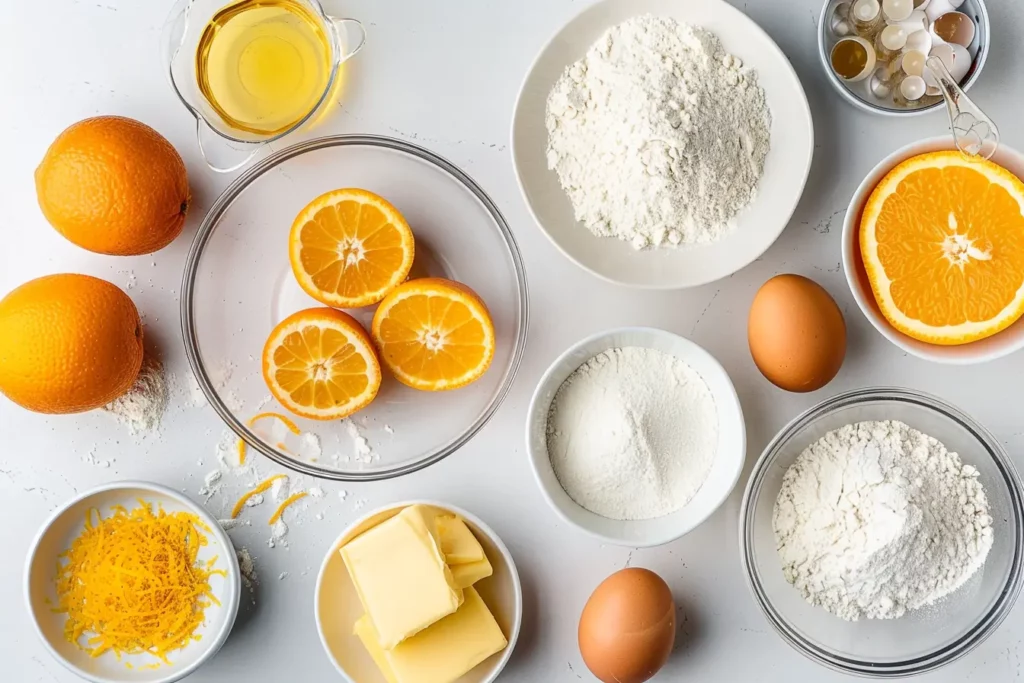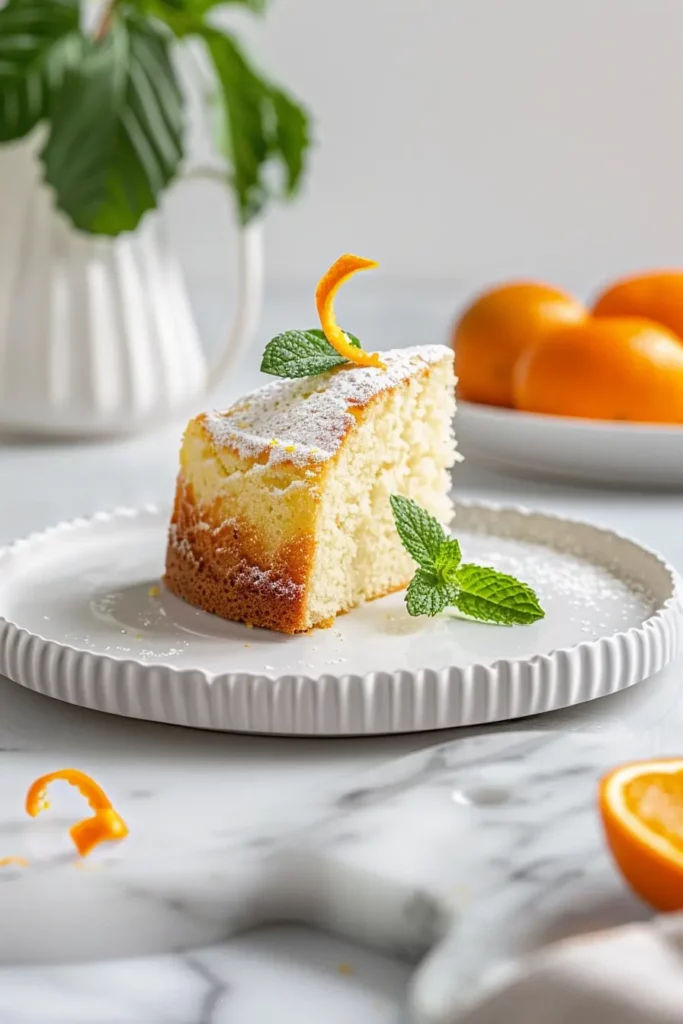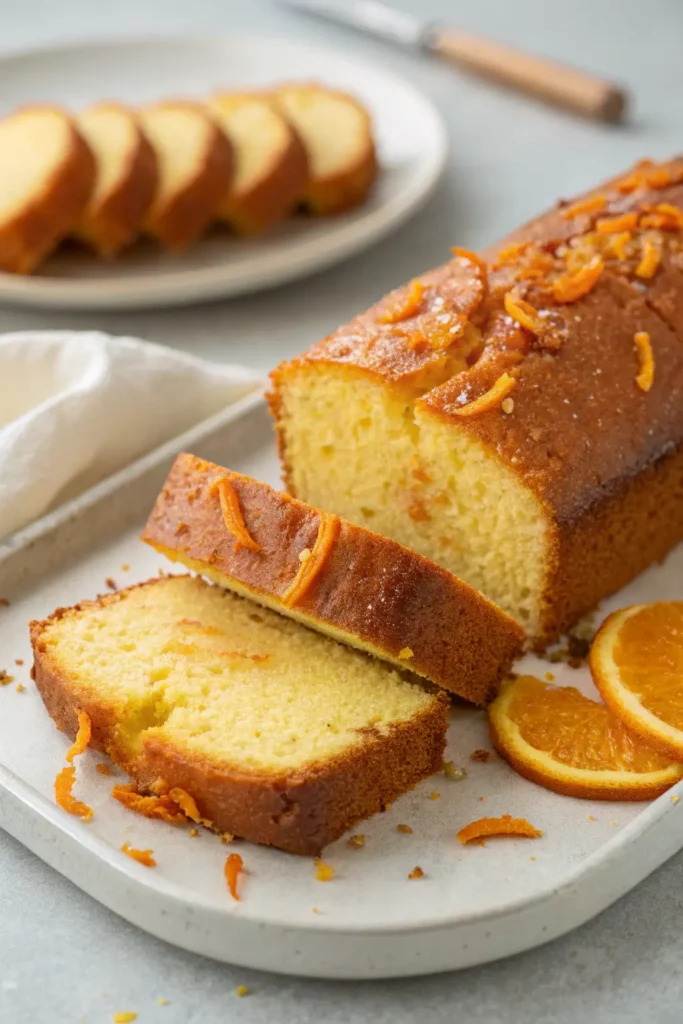🖋️ Written by Emma
Orange Pound Cake is the kind of dessert that feels nostalgic and fresh all at once. Its bright citrus notes, dense buttery crumb, and golden crust make it the perfect bake for nearly any occasion. Whether you’re serving it with morning coffee or as an after-dinner treat, this cake stands out for its rich flavor and simplicity.
But baking the perfect orange pound cake takes more than just following a recipe. From selecting the juiciest oranges to mixing the batter correctly, small details make a big difference. In this guide, you’ll uncover 9 tested secrets that transform a basic loaf into a soft, fragrant, and beautiful dessert — without bitterness or baking fails. Get ready to avoid common mistakes, master texture, and unlock the kind of results bakers dream about.
The Best Orange Pound Cake for Any Occasion
What Makes Orange Pound Cake Unique
Orange pound cake isn’t just another citrus dessert. Its deep, rich flavor comes from the combination of real orange zest, fresh juice, and a buttery pound cake base. This blend creates a taste that’s both bold and smooth — the kind that lingers pleasantly after each bite.
Unlike lemon or lime cakes, orange adds natural sweetness with just a hint of tang. That balance makes it ideal for all kinds of settings — from family brunches to festive holiday gatherings. It’s dense enough to satisfy but light enough not to overwhelm. Plus, the natural oils in orange zest add an aromatic punch that fills your kitchen as it bakes.
What truly sets orange pound cake apart is how well it adapts. It works beautifully as a loaf, bundt, or even in cupcake form. Add a drizzle of orange glaze, and you’ve got a bakery-style finish without extra effort.
History of Pound Cake and How Citrus Was Added
The original pound cake dates back to the 1700s. Named for its simple ratio — a pound each of flour, butter, sugar, and eggs — it became a staple in many kitchens for its straightforward recipe and reliable results.
But as tastes evolved, bakers began experimenting. Citrus became a natural match. Oranges, in particular, brought brightness to the otherwise rich and heavy pound cake. Over time, the orange pound cake carved its own place in dessert culture, especially in regions where fresh citrus was easy to find.
Today, the addition of oranges adds more than flavor. It introduces moisture, texture, and a vibrant color. It’s no longer just about weight — it’s about balance, aroma, and a memorable bite every time.
Ingredients for Perfect Orange Pound Cake

Fresh, Quality Ingredients That Make the Difference
The secret to an unforgettable orange pound cake begins with what you put into the bowl. Skip the shortcuts — this cake shines when made with real, full-flavored ingredients. Here’s what makes all the difference:
| Ingredient | Why It Matters |
|---|---|
| Unsalted Butter | Provides richness and classic dense texture |
| Large Eggs | Helps bind the cake and adds moisture |
| All-Purpose Flour | Creates the perfect balance between structure and softness |
| Fresh Oranges | Juice and zest bring bold citrus flavor and moisture |
If you’ve ever made a cake that came out too dry, your butter or flour ratio was likely off. To avoid that, measure ingredients accurately — especially when making citrus cakes, where flavor depends on balance.
Looking for a similar citrus treat? Try this Key Lime Pound Cake — it also uses fresh zest for punchy flavor.
Why Use Both Orange Juice and Zest
To make the most flavorful orange pound cake, you need both juice and zest. Orange juice adds subtle sweetness and keeps the cake moist, while zest brings that unmistakable citrus aroma that fills your kitchen as it bakes.
But here’s the catch — zest must be fresh. Pre-packaged zest doesn’t deliver the same oils. Use a fine zester and avoid the bitter white pith. This one step is key to avoiding the flat or sour taste many citrus cakes suffer from.
Need a glaze idea that pairs well? Try a drizzle like the one from this Pineapple Coconut Chess Bars for tropical inspiration.
Together, juice and zest create flavor depth without overwhelming the cake’s natural richness. Some bakers add a splash of orange extract or liqueur — but it’s optional. The real power still comes from the fruit.
How to Make Orange Pound Cake Step by Step
Mixing the Batter the Right Way

A smooth batter is the heart of any good orange pound cake. The texture depends on the order and method used when combining your ingredients. If you want a moist cake with a fine crumb, follow this process carefully.
Start by creaming the butter and sugar. Beat them on medium-high speed for 4–5 minutes until the mixture is fluffy and pale. This step traps air, helping the cake rise later.
Add the eggs one at a time. Mix well after each egg. Rushing this step can cause the batter to curdle.
Now add the orange zest and vanilla extract. These go in before the dry ingredients so they mix evenly.
In a separate bowl, combine your flour, salt, and baking powder. Slowly add these dry ingredients to the batter while alternating with the fresh orange juice. Start and end with the flour to avoid thinning the batter too much.
Avoid overmixing. As soon as everything is combined, stop. Overworking the batter leads to a tough, dry cake.
Need a visual? This smooth batter technique is similar to what’s used in these Banana Pudding Dip and Peanut Butter Pie recipes — rich, but not heavy.
Baking Tips for Golden Crust and Moist Center
Preheat your oven to 325°F (163°C). A lower temperature ensures that the cake bakes evenly, avoiding a burnt crust or undercooked center.
Grease your loaf or bundt pan generously. For extra security, line the bottom with parchment paper. This prevents sticking and keeps the cake intact when removing from the pan.
Pour in the batter and smooth the top. Tap the pan gently on the counter to release air bubbles.
Bake for 60–70 minutes, depending on your oven and pan. Begin checking at the 55-minute mark. Insert a toothpick — it should come out clean or with just a few moist crumbs.
Let the cake rest in the pan for 15 minutes, then transfer it to a wire rack to cool completely.
Here’s a handy table to guide your baking process:
| Step | Details |
|---|---|
| Creaming | Butter + sugar, 4–5 minutes |
| Eggs | One at a time, mix well |
| Dry & Wet Mix | Alternate flour and juice |
| Bake | 325°F for 60–70 min |
| Cool | 15 min in pan, then rack |
Common Orange Pound Cake Mistakes to Avoid

Why Your Pound Cake Might Not Rise
When your orange pound cake comes out flat or dense, it’s frustrating — especially after carefully prepping ingredients. But the cause often comes down to a few overlooked steps.
First, check your leavening agents. Most pound cakes rely on eggs and the air incorporated during creaming. However, if your recipe includes baking powder or soda, make sure they’re fresh. Expired leaveners won’t do the job.
Next, it’s about mixing technique. Overmixing or undermixing ruins the balance. You want the batter just combined — not overworked. Using cold ingredients, especially butter, can also reduce volume.
Finally, consider your oven. Uneven heat or incorrect temperature ruins rise. Always preheat your oven, and use an oven thermometer if needed.
Here’s a quick table to help identify common rising issues:
| Problem | Cause | Fix |
|---|---|---|
| Flat Cake | Old leaveners or cold ingredients | Use fresh baking powder, room-temp ingredients |
| Dense Texture | Overmixed or under-creamed batter | Cream longer, mix dry/wet just until combined |
| Sunken Center | Oven too hot or cake removed too soon | Bake fully and avoid opening door early |
If you’ve had similar issues with other cakes, these Easy Strawberry Parfaits make a no-bake backup that never fails.
Fixing Bitterness in Orange Desserts
One of the biggest issues with orange pound cake is bitterness. It usually comes from the zest, not the juice. If you’re zesting too deep into the peel, you’re picking up the white pith — and that’s the problem.
Always use a microplane and stop as soon as the orange’s white layer appears. The zest should be fine, fragrant, and bright orange — never thick or chunky.
Another common cause is overbaking. A dry, slightly burnt crust adds an unwanted bitter note. Check your oven temperature and baking time. Every oven runs differently, so test with a toothpick before the full time is up.
Finally, don’t skip sugar balancing. If your batter is very tangy, a few extra tablespoons of sugar can round out the flavor.
Want something on the sweeter side? Check out Pineapple Coconut Chess Bars for an ultra-sweet alternative.
Variations of Orange Pound Cake

Orange Glaze, Chocolate Swirls, and More
The beauty of orange pound cake is how easily it adapts. Want it lighter? Add glaze. Craving richness? Swirl in chocolate. From toppings to textures, the possibilities are endless.
One popular twist is the orange glaze. Made with powdered sugar and freshly squeezed orange juice, it adds both sweetness and shine. Drizzle it on while the cake is still slightly warm so it soaks into the top layer. For a stronger citrus hit, stir in some orange zest or a few drops of orange extract.
If you’re a chocolate fan, mix in dark chocolate chunks or cocoa swirl. Orange and chocolate pair beautifully, creating contrast in both color and taste. Fold melted chocolate into a portion of the batter, then swirl gently with a knife before baking.
Feeling tropical? Try adding crushed pineapple or coconut flakes. Inspired by Pineapple Coconut Chess Bars, this twist brings a sweet island feel to your loaf.
Here’s a quick comparison of creative pound cake styles:
| Variation | Flavor Profile | Add-ons |
|---|---|---|
| Orange Glaze | Sweet, bright, citrusy | Powdered sugar, orange juice, zest |
| Chocolate Swirl | Rich, bittersweet, bold | Melted dark chocolate, cocoa |
| Tropical Style | Sweet, juicy, summery | Crushed pineapple, coconut flakes |
Substituting Ingredients for Different Textures
Looking to change the texture of your orange pound cake? Small swaps go a long way. Replace half the butter with Greek yogurt for a slightly tangier, moister loaf. Want something even fluffier? Add a teaspoon of sour cream or buttermilk to the batter.
For a more cake-like crumb, sift the flour twice. This introduces more air and prevents a tight, dense texture. Avoid whole wheat flour or almond flour unless you’re ready to adjust other ratios — those can drastically change results.
Baking gluten-free? Use a 1:1 gluten-free flour blend and add an extra egg for structure. Pair it with citrus-forward recipes like these Blueberry Sour Cream Scones that also shine with bright fruit notes.
Want to keep things dairy-free? Swap butter for plant-based margarine and use oat milk with a splash of vinegar for the acidity.
Storing and Serving Orange Pound Cake

Best Ways to Store for Longer Freshness
You’ve baked the perfect orange pound cake — now make sure it stays that way. Proper storage keeps the cake moist, flavorful, and ready to enjoy for days.
First, always let the cake cool completely before storing. Wrapping a warm cake traps moisture and causes sogginess. Once cool, wrap it tightly in plastic wrap or place it in an airtight container. Store at room temperature for up to 3 days.
For longer storage, refrigerate it. Keep it well wrapped, and it’ll last up to 7 days. Just be sure to let it come to room temperature before serving, as cold can mute the flavor.
Want to freeze it? Pound cake freezes beautifully. Wrap the entire cake — or individual slices — in plastic wrap, then aluminum foil. Store in the freezer for up to 3 months.
Here’s a quick table to break it down:
| Storage Method | Duration | Tips |
|---|---|---|
| Room Temperature | Up to 3 days | Wrap tightly to prevent drying |
| Refrigerator | Up to 7 days | Allow to return to room temp before serving |
| Freezer | Up to 3 months | Double-wrap to avoid freezer burn |
If you love make-ahead treats, check out this freezer-friendly Peanut Butter Pie for another dessert that holds up well over time.
Serving Ideas from Brunch to Dessert Trays
Orange pound cake can be served in dozens of beautiful, easy ways. For a simple presentation, dust the top with powdered sugar or top with a citrus glaze. You can also pair it with fresh fruit like strawberries or blueberries for color and contrast.
Want to make it more indulgent? Serve slices with a dollop of whipped cream or a scoop of vanilla ice cream. A drizzle of melted chocolate or orange caramel sauce adds a gourmet touch with minimal effort.
For brunch spreads, slice the cake thin and arrange it with pastries and scones like these Blueberry Sour Cream Scones. The citrus flavor cuts through richness, making it a great complement to savory items too.
Hosting a holiday table? Decorate with candied orange slices for a festive look. They’re easy to make and add sparkle and flavor.
No matter how you serve it, this cake delivers. It’s elegant enough for special occasions, yet easy enough for everyday baking.
Fun Facts About Orange Pound Cake

Origins of the Name “Pound Cake”
The term “pound cake” comes from its original formula — a pound of flour, sugar, butter, and eggs. That’s it. No baking powder, no extracts, no frills. It was created for simplicity and memorability, especially in the 1700s when most home bakers didn’t use written recipes.
This old-school recipe produced a dense, rich cake that could feed large families. Over time, bakers added flavors, including citrus, to give it depth and variety. That’s how modern variations like orange pound cake came into play.
The orange version became especially popular in warmer regions where citrus fruits were readily available. As refrigeration improved, keeping fresh juice and zest on hand became easier — making this fruity twist even more accessible.
Today, the pound cake still follows the same spirit of the original: simple, reliable, and made to be shared. Orange just happens to be one of the most loved upgrades.
Interesting Facts and Myths You Didn’t Know
There’s more to orange pound cake than just butter and zest. Some fun facts might surprise you — and maybe even give you some ideas for your next bake.
| Fun Fact | Details |
|---|---|
| It has no leavening | Traditional pound cakes rise solely from eggs and air trapped during mixing. |
| Baked for travel | Historically, pound cakes were baked for long journeys and kept well without refrigeration. |
| Cake with medicinal oranges | In some cultures, orange cakes were given to aid digestion or treat colds due to citrus vitamin C. |
You’ll even find variations like this Mexican Cornbread that blend traditional recipes with modern twists — just like how citrus transformed the classic pound cake.
Many also believe pound cake gets better with time. Let it sit overnight, and you may notice the flavors become even more pronounced — especially in citrus-based versions like this one.
Orange Pound Cake Strain vs. Dessert
What Is Orange Pound Cake Strain?
You may have come across the term Orange Pound Cake outside of baking. Surprisingly, it’s also the name of a cannabis strain known for its bright citrus aroma and sweet, relaxing effects. This hybrid variety gets its name from dessert-like flavor profiles, but don’t confuse it with the cake.
The strain is typically a cross between Orange Sherbet and Wedding Cake, bred to produce calming, euphoric sensations. It’s often chosen for relaxation, stress relief, and late-night use. Though inspired by baked goods, it contains no actual ingredients used in baking.
So if you’re searching for a recipe and land on something labeled as “strain,” double-check the source. One is served on a plate. The other? Not so much.
Key Differences Between the Dessert and the Cannabis Strain
Although they share a name, the orange pound cake strain and the cake we’ve been baking all along are completely unrelated beyond flavor inspiration. Let’s break it down:
| Category | Dessert | Cannabis Strain |
|---|---|---|
| Main Use | Eaten as a sweet, citrus-flavored cake | Smoked or vaped for relaxation and euphoria |
| Flavor Notes | Sweet, buttery, and citrusy | Citrus, vanilla, and sweet earthiness |
| Ingredients | Flour, sugar, eggs, orange zest and juice | Cannabis plant material — no actual cake |
If your goal is a citrus treat to serve with coffee, stick with the cake version. But if you’re exploring relaxation in other forms, the strain may come up in your search. Just know: they aren’t interchangeable.
Curious about other flavor-packed bakes? These Elephant Ears offer buttery crispness with just the right sweetness — no confusion required.
FAQ: Orange Pound Cake Questions Answered
Why did the pound cake get its name?
The name “pound cake” comes from its original recipe: one pound each of flour, butter, sugar, and eggs. This made the recipe easy to remember before written cookbooks were common. While modern versions — like orange pound cake — tweak those ratios, the name has stuck for centuries.
What strain is Orange Pound Cake?
Orange Pound Cake is also the name of a hybrid cannabis strain. It’s known for a sweet, citrus-forward aroma and calming effects. However, it’s unrelated to the baked dessert other than sharing a similar scent and name. Be sure to double-check when searching recipes online.
How to reduce bitterness in orange cake?
Bitterness in orange cake usually comes from the pith — the white layer under the orange peel. When zesting oranges, avoid going too deep. Use only the outer orange layer, and mix it into the batter thoroughly. Also, check your baking time. Overbaked cakes often taste slightly bitter. Need a sweeter backup idea? These Easy Strawberry Parfaits always turn out just right.
What causes a pound cake not to rise?
A few things can cause pound cake to fall flat: cold ingredients, expired leaveners, or overmixed batter. Proper creaming of butter and sugar introduces air, which helps the cake lift in the oven. In recipes like orange pound cake, using room-temperature ingredients and gentle mixing ensures the perfect rise.
What is a fun fact about pound cake?
Here’s a sweet one: Pound cake was often baked to last for travel — especially on long sea voyages. Its dense texture and simple ingredients made it durable and satisfying. Today, we upgrade it with flavors like citrus or coconut. Want to see a tropical twist? Try this Pineapple Coconut Chess Bars recipe.
Why is it called a pound?
It refers to the use of a pound of each main ingredient in the traditional version. The term made it simple to remember before modern measuring cups were available. Even though today’s orange pound cake doesn’t use exact pounds, the method still honors that old formula.
Final thoughts
Orange Pound Cake offers everything you want in a homemade dessert — rich texture, bright citrus flavor, and the kind of versatility that works for any occasion. From choosing the right ingredients to mastering the baking process, even small tweaks can make a big difference in flavor, texture, and presentation.
Whether you keep it classic or add a personal twist like glaze or chocolate, this cake is a reliable crowd-pleaser. Avoid common mistakes, store it properly, and serve it in style — and you’ll have a go-to recipe you can bake again and again.
For more creative baking inspiration and marketing ideas, explore the Facebook and Pinterest.



